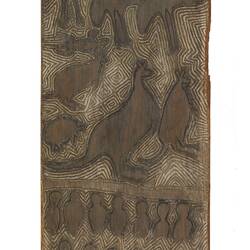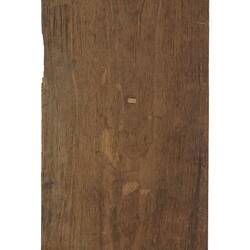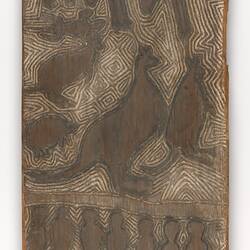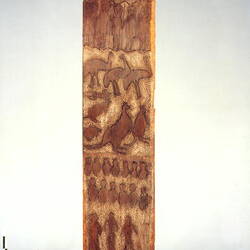Summary
Grave markers were recorded in association with Aboriginal burial places at the point of colonisation, however generally were stones or carved trees, not wooden plaques like this one. The design elements here are consistent with the classic patterning of southeastern Australia Aboriginal art created on shields in particular, however the incorporation of the three registers in this work is not.
Physical Description
A plaque made from a single piece of hardwood incised with figures and lines and painted with natural pigments. The figures are painted with red ochre and the wavy lines are infilled with white pipe clay. It has two registers: the first being emus, a lizard, kangaroos and an echidna; and the second being two rows of anthropomorphic figures of the head and torso and the last row has three entire figures next to a series of diamond motifs.
Significance
The 'Bungaleen Memorial' was made at Coranderrk in 1866 and the artist is thought to have been Simon Wonga (c.1824-1874), the nguruungaeta or headman of the Wurundjeri-Balluk clan. Its shape is similar to a European headstone but it was not placed on Bungaleen's grave in Melbourne General Cemetery where he was buried beside his older brother Wurrabool, who had died ten years earlier. During Bungaleen's lifetime, Wonga had sought alliances with the clans of Gippsland and would no doubt have known Bungaleen personally at least during his time as a messenger for the Port Phillip Protectorate. John Hinkins had the plaque until 1899 when he donated it to the museum. The year after Bungaleen died, Hinkins had requested assistance from the Central Board of Aborigines to erect a monument in memory of Bungaleen, but it was refused on the grounds his grave lay within the 'Common Section' of the cemetery. The Board Secretary requested John Green, the manager of Coranderrk Aboriginal Station, have a monument carved in wood that would be 'appropriate and characteristic', and this together with the following commentary from Robert Brough Smyth in his book, 'The Aborigines of Victoria' published in 1878 is the basis for the attribution of Wonga as the carver of this plaque. 'On the death of Bungeleen one of the men of the Yarra tribe was requested to make a suitable design for a tombstone to be placed over his grave; and he furnished accordingly the following picture. It is carved in wood. The artist is now dead; and it is impossible to give any explanation of the picture. Mr John Green says that the Aborigines of the Yarra do not know what meaning he attached to the several figures; but they suppose that the men represented in the upper part of the drawing are friends who have been appointed to investigate the cause of the death of Bungeleen; the figures of the birds and animals (emus, lizard, wombat (?), and kangaroos) indicate that he did not die for lack of food; and the strange - somewhat obscure-forms below the hollow band are those of Mooroops, or spirits who have caused the death of the Aboriginal by their wicked enchantments. The carving is excellent; the engraving accurately represents the figures.'
More Information
-
Object/Medium
Grave marker
-
Maker
-
Cultural Groups
-
Locality
-
Date Produced
-
Date Collected
-
Object Measurements
1300 mm (Length), 335 mm (Width), 40 mm (Height)
-
Person Commemorated
Bungaleen
This plaque was made to commemorate the death of Thomas or Tommy Bungaleen. -
Keywords
-
References
[Book] Museum Victoria. 2004. Treasures of the Museum. Victoria, Australia. 206.
-
Type of item
-
Discipline
-
Category
-
Collecting Areas
-
Medium
Natural pigments
-
Technique
Carving, painting
-
Support
Wood




